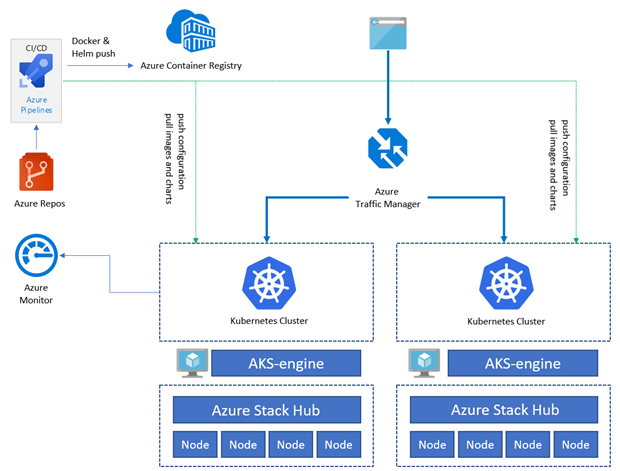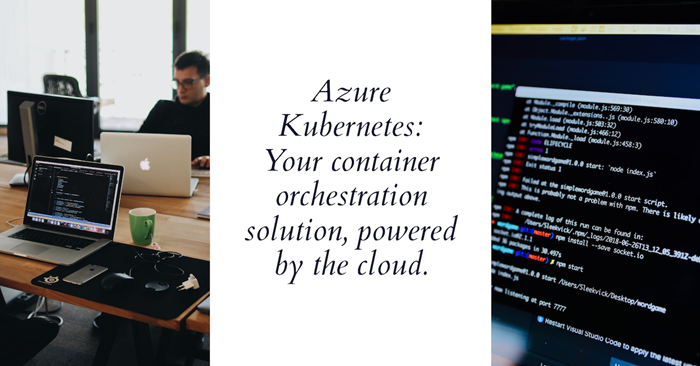AI is poised to create whole new ways of working. How can you use AI to fix work at your organization? Findings from the @Microsoft Work Trends Index Annual Report points to 3 insights you need to adopt AI in a timely, responsible way.
Unpacking Kubernetes in Azure: Navigating Services and Setup
As businesses continue to embrace cloud computing and modernize their applications, the need for efficient management and orchestration of these applications becomes paramount. This is where Kubernetes comes into play. Kubernetes is an open-source container orchestration platform that simplifies the deployment, scaling, and management of applications. If your business is considering migrating to Kubernetes in Azure, it's important to have a clear understanding of the services available and how to set up your infrastructure. But whether you are a small business looking to streamline your operations or a large enterprise seeking scalable and efficient solutions, understanding and harnessing the power of Kubernetes can greatly benefit your business. In this blog post, we will delve into the world of Kubernetes in Azure, exploring the various services and setup options available. We will provide a comprehensive overview of the key concepts and steps involved, helping you make informed decisions and ensuring a smooth transition to this powerful container orchestration platform. So, let's dive in and unpack Kubernetes in Azure, discovering the potential it holds for your business.
Understanding the Benefits of Kubernetes in Azure
1. Seamless Integration
One of the major benefits of harnessing Kubernetes in Azure is the ease of integration. Kubernetes is a powerful container orchestration platform that allows you to manage and scale your applications with ease. By integrating Kubernetes into Azure, you can take advantage of the seamless integration with other Azure services and tools. Kubernetes integrates seamlessly with Azure services, such as Azure Container Registry and Azure DevOps, enabling end-to-end CI/CD pipelines. This allows developers to easily build, test, and deploy applications using familiar tools and workflows. This also means that you can easily deploy and manage containerized applications on Azure, without having to worry about complex setup or configuration.
2. Streamlined Development and Deployment Processes
One of the key benefits of using Kubernetes in Azure is the ability to streamline the development and deployment processes for applications. With Kubernetes, developers can define application requirements and dependencies in a declarative configuration file, enabling automated and repeatable deployments. This ensures that applications are deployed consistently across environments, reducing the occurrence of configuration errors and increasing reproducibility. Kubernetes also provides a centralized platform for managing and orchestrating containers, making it easier to scale and manage applications. With its built-in load balancing and self-healing capabilities, Kubernetes ensures that applications are always available and performant, even during peak usage. These built-in mechanisms for continuous deployment mean seamless updates and rollbacks without downtime. By leveraging the capabilities of Kubernetes in Azure, businesses can accelerate the development cycle and rapidly respond to changing market demands.
3. Scalability and Elasticity
Another significant advantage of using Kubernetes in Azure is its ability to scale applications effortlessly. Kubernetes has a built-in scaling feature that allows applications to automatically scale up or down based on resource usage or defined metrics. This ensures that applications can handle increased traffic or demand without manual intervention, providing a seamless user experience. With Kubernetes, resources are utilized efficiently, and applications are always available to users, even during peak times. Scalability is crucial for businesses that experience fluctuating workloads or seasonal demand patterns. Kubernetes in Azure can tap into this scalability with tools such as the Autoscaler and Virtual Machine Scale Sets, to achieve even greater scale and elasticity. Kubernetes in Azure provides high availability by allowing you to distribute your applications across multiple nodes or regions. This means your applications are always available, even in the event of a failure.
4. High Availability and Fault Tolerance
Kubernetes in Azure offers robust mechanisms for ensuring high availability and fault tolerance of applications. Kubernetes provides built-in features such as service discovery, load balancing, and automatic failover, so that applications remain accessible and operational even in the event of failures or outages. When combined with the resilience and redundancy features of Azure, such as Availability Zones and Azure Load Balancer, businesses can achieve a highly available and fault-tolerant infrastructure for their applications. This enhances the reliability of the applications and minimizes the impact of potential disruptions and provide uninterrupted services to customers.
5. Hybrid and Multi-cloud Deployments
Kubernetes in Azure also empowers businesses with the flexibility to adopt a hybrid or multi-cloud deployment strategy. With Azure's powerful networking capabilities and Kubernetes' ability to manage clusters across different environments, businesses can seamlessly deploy and manage applications both in on-premises environments and in other cloud providers. This flexibility allows businesses to reap the benefits of both worlds - harnessing the scalability and cost-effectiveness of the cloud while retaining control over sensitive data or complying with specific regulations. It supports hybrid scenarios, allowing users to connect their AKS cluster with on-premises resources or other cloud services. By utilizing Kubernetes in Azure, businesses can create a hybrid or multi-cloud architecture that meets their specific requirements and ensures optimal performance and availability.

Delving into Azure Kubernetes Architecture
Azure Kubernetes Service (AKS) - Azure Kubernetes Service (AKS) is a managed container orchestration service provided by Microsoft Azure. It simplifies the deployment, management, and scaling of containerized applications using Kubernetes. AKS allows you to focus on your application development, while Azure takes care of the underlying infrastructure and Kubernetes management. AKS takes care of creating and managing the necessary virtual machines, networking resources, and storage, allowing developers to focus on deploying and running their applications.
An AKS cluster is a managed container orchestration service provided by Microsoft Azure. It allows users to easily deploy, manage, and scale containerized applications using Kubernetes. To create an AKS cluster, you need to define the desired configuration, such as the number and size of nodes, networking options, and authentication methods. AKS will then provision and configure the required resources accordingly. Once the cluster is up and running, you can deploy your containerized applications using Kubernetes manifests or Helm charts. AKS provides integration with Azure Container Registry for storing and managing container images, making it easy to deploy and update applications.
AKS also offers several features for managing and scaling your applications. It supports automatic scaling of nodes based on CPU utilization or custom metrics, ensuring your applications have enough resources to handle the workload. It also integrates with Azure Monitor and Azure Log Analytics for monitoring and troubleshooting your applications.
In addition, AKS provides strong security and compliance capabilities. It offers features such as role-based access control (RBAC) ensuring that only authorized users and services can interact with your containers, network security groups, and built-in support for Microsoft Entra (formerly Azure Active Directory) for authentication and authorization, allowing you to control access to your clusters and resources. This allows you to control who can access and manage your AKS cluster and the deployed applications.
Azure Container Registry (ACR) - When using Kubernetes in Azure, there are other several key architectural components that work together to provide a comprehensive solution. One of these components is Azure Container Registry. This is a private registry service that allows you to store and manage your container images. It provides secure access control, scalability, and integration with other Azure services. With Azure Container Registry, you can easily build, store, and deploy your container images to Kubernetes clusters in Azure.
One of the key advantages of using ACR is its secure access control capabilities. Users can define access policies to control who can push, pull, or delete container images from the registry. This ensures that only authorized individuals or systems have access to the images, protecting them from unauthorized use or tampering. It is also built on Azure's robust infrastructure, which allows it to handle large-scale container deployments with ease. This means that as your containerized application grows and requires more resources, the registry can scale up accordingly to meet the demand.
Azure Pipelines - Another important component is Azure Pipelines. This is a cloud-based continuous integration and delivery (CI/CD) service that allows you to automate the building, testing, and deployment of your applications. With Azure Pipelines, you can create pipelines that connect to your source code repositories, build your container images, run tests, and deploy your applications to Kubernetes clusters. This means you can automate the process of building, testing, and deploying your applications. With Azure Pipelines, you can create pipelines that connect to your source code repository, such as GitHub or Azure Repos. These pipelines allow you to define a series of steps that will be executed whenever changes are made to your code. It also provides built-in features for security and compliance, such as role-based access control and audit logs.
Another benefit of Azure Pipelines is its flexibility. It supports a wide range of programming languages, platforms, and tools. Whether you're developing a .NET application, a Node.js server, or a mobile app, Azure Pipelines has you covered. It also integrates seamlessly with other Azure services, such as Azure DevOps and Azure Kubernetes Service, allowing you to build end-to-end solutions.
Azure Pipelines can greatly improve the efficiency and quality of your development process. By automating the build and testing phases, you can catch bugs and issues early on, reducing the time and effort required for manual testing. The deployment phase can also be automated, allowing you to release new features and updates more frequently and reliably.
Helm - Last but not least is Helm, another key component of the Kubernetes architecture in Azure. Helm is a powerful tool for managing Kubernetes applications. With Helm, you can define, install, and upgrade complex applications with ease. It simplifies the process of packaging your applications and their dependencies, making it more efficient to deploy and manage them in Kubernetes clusters. With Helm, you can easily share and distribute your applications as reusable packages called charts. A Helm Chart is a collection of files that describe the structure of your application, including its Kubernetes resources, such as deployments, services, and config maps. These Charts cover a wide range of popular applications and services, such as databases, monitoring tools, and web servers. By leveraging these pre-built Charts, you can save time and effort in deploying and managing common applications in your Kubernetes clusters. With Helm Charts, you can easily customize and modularize your application configurations, making it easier to manage and deploy them across different environments.
Installing and upgrading applications using Helm is also straightforward. With a single command, you can install or upgrade an application and all its dependencies. Helm takes care of resolving dependencies and ensures that your applications are deployed consistently across your Kubernetes clusters. This makes it easier to keep your applications up-to-date and maintain consistency across different environments.
These three components; Azure Container Registry, Azure Pipelines, and Helm work together to provide a seamless experience for deploying and managing containerized applications in Kubernetes clusters in Azure.
Exploring Service Options for Kubernetes in Azure
When it comes to deploying and managing Kubernetes in Azure, there are several service options available that can help streamline the process and provide additional features and functionalities. Today, we will focus on Azure Container Instances, Azure Service Fabric, and Azure Dev Spaces.
- Azure Container Instances (ACI) - Azure Container Instances (ACI) is an innovative solution that allows users to run containers without the need to manage the underlying infrastructure. ACI provides a simple and cost-effective way to deploy containerized applications in the Azure cloud environment.
- Azure Service Fabric - Azure Service Fabric is a distributed systems platform that offers a convenient and efficient way to develop and deploy microservices-based applications. One of its notable features is its built-in support for containerization and orchestration, which greatly simplifies the process of managing and scaling applications.
- Azure Dev Spaces - Azure Dev Spaces is a development tool that provides developers with the ability to work on Kubernetes applications without the need to set up their own Kubernetes cluster. This tool simplifies the development process by easily create a development environment that mirrors the production environment, ensuring that the application works seamlessly when deployed. This tool makes it easy to iterate and debug code, as developers can quickly make changes and see the results in real-time.
Automating Workflows with Azure Kubernetes
Azure provides a range of features and tools that make it easier to automate workflows with Kubernetes. One of the main benefits of using Azure Kubernetes Service (AKS) is that it simplifies the process of deploying, managing, and scaling Kubernetes clusters.
There are many options for deployment. You can use the Azure portal, Azure CLI, or Azure PowerShell to deploy a Kubernetes cluster in just a few steps. Additionally, Azure Resource Manager templates can be used to define and deploy clusters consistently across different environments.
Once the cluster is deployed, managing it becomes easier with Azure's monitoring and diagnostics capabilities. Azure Monitor provides insights into the health and performance of your cluster, allowing you to identify and troubleshoot issues quickly. Azure Log Analytics can be used to collect and analyze logs from your Kubernetes cluster, helping you gain deeper visibility into its operations.
Scaling your Kubernetes cluster is another area where Azure simplifies automation. AKS supports horizontal pod autoscaling, which automatically adjusts the number of pods in your deployment based on resource utilization. You can even define custom metrics and thresholds to control the scaling behavior! Are we having fun yet?

Optimizing Performance and Monitoring Kubernetes in Azure
When it comes to optimizing performance and monitoring Kubernetes in Azure, there are several tools and best practices that can be employed. To optimize performance, it is important to properly configure resource limits and requests for containers in Kubernetes. Setting appropriate limits will ensure that each container has enough resources to run efficiently, while requests help Kubernetes scheduler make optimal placement decisions. By right-sizing resources, unnecessary wastage can be avoided, leading to better overall system performance. Regular monitoring and analysis of logs and metrics can provide valuable insights into system behavior and help identify performance bottlenecks. Tools like Azure Log Analytics and Azure Application Insights can be used to collect, analyze, and visualize logs and metrics for troubleshooting and performance tuning. The following tools are very useful for optimization and monitoring.
- Azure Monitor - One important tool is Azure Monitor, which provides insights into the performance and health of the Kubernetes cluster. It can monitor various metrics such as CPU and memory usage, network traffic, and application logs. Azure Monitor also lets you set up alerts for specific thresholds and conditions, allowing quick response to any performance issues.
- Azure Container Insights - Another useful tool is Azure Container Insights, which gives you detailed visibility into the performance of containerized applications running in Kubernetes. It can also monitor the performance of individual containers, as well as provide insights into cluster-level metrics and resource utilization. Azure Container Insights supports integration with other monitoring tools such as Prometheus and Grafana for advanced analytics and visualization.
- Horizontal Pod Autoscaler (HPA) - Horizontal Pod Autoscaler (HPA) can dynamically scale the number of pods based on workload demand. This means resources will be efficiently allocated to meet performance requirements without over-provisioning.
Optimizing performance and monitoring Kubernetes in Azure requires a combination of tools like Azure Monitor, Azure Container Insights, and appropriate resource allocation. Regular monitoring and analysis of logs and metrics can provide insights for identifying and resolving performance issues effectively. By utilizing these resources, you can ensure that your Kubernetes clusters are running efficiently and effectively.
Azure Kubernetes: Transitioning from Theory to Practice
Transitioning from theory to practice when deploying Kubernetes on Azure can be a challenging task, but with the right approach and knowledge, it is definitely achievable. Here are some practical tips and recommendations to help you navigate this transition successfully.
- First and foremost, it is crucial to have a solid understanding of both Kubernetes and Azure. Make sure you have a good grasp of the key concepts and terminology associated with Kubernetes, such as pods, services, and deployments. Additionally, familiarize yourself with the Azure services that are specifically designed to support Kubernetes, such as Azure Container Instances (ACI) and Azure Kubernetes Service (AKS). If you've come this far with us, you've already got a pretty good head start!
- Next, start small and gradually scale up your Kubernetes deployment on Azure. Begin by deploying a simple application or workload on a single node cluster. This will allow you to get hands-on experience and become comfortable with the basics of managing Kubernetes on Azure. As you gain confidence, you can gradually add more nodes and scale up your deployment to handle larger workloads.
- Make sure you use the available tools and resources provided by both Kubernetes and Azure. Kubernetes provides a rich ecosystem of tools for managing and monitoring your cluster, such as kubectl for command-line management and Prometheus for monitoring. Azure also offers a variety of tools and services that we've only touched on here to get you started. There are plenty of tools available to help you optimize and troubleshoot your Kubernetes deployment.
- Then, take advantage of automation and infrastructure-as-code (IaC) principles when deploying Kubernetes on Azure. Tools like Azure Resource Manager (ARM) templates and Terraform can help you define and provision your infrastructure in a repeatable and scalable manner. This will make it easier to manage and update your Kubernetes deployment as your needs evolve over time.
- Lastly, tap into the power of the community. Join online forums, attend meetups or conferences, and engage with other professionals like CSW Solutions, who are also working with Kubernetes on Azure. Learning from others' experiences and sharing your own challenges and successes can greatly accelerate your learning curve and provide valuable insights. By following these practical tips and recommendations, you can make the transition from theory to practice when deploying Kubernetes on Azure a smooth and successful experience.
Final Thoughts
As businesses continue to embrace the benefits of cloud computing, Kubernetes has emerged as a crucial tool for managing and orchestrating applications. In Azure, Kubernetes offers a comprehensive set of services and setup options that give businesses the keys to unlock agility, scalability, and reliability in their operations. By streamlining development and deployment processes, providing scalable and elastic infrastructure, ensuring high availability and fault tolerance, and enabling hybrid or multi-cloud deployments, Kubernetes in Azure empowers businesses to thrive in the modern digital landscape. So, if you're looking to modernize your applications and leverage the full potential of the cloud, consider diving into Kubernetes in Azure and discover the endless possibilities it holds for your business.

